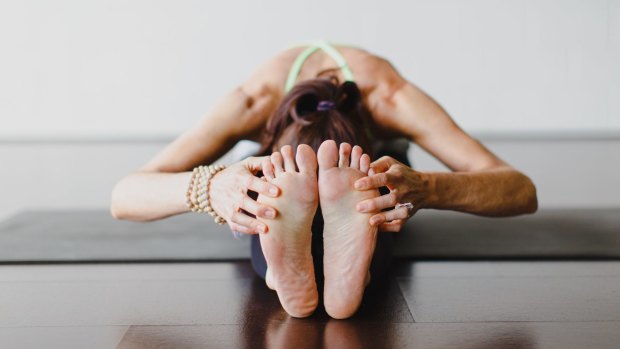This was published 6 years ago
How to age well with yoga, and avoid the risk of injury
By Carol Krucoff
Yoga may hold a key to ageing well, suggests a growing body of research into its potential benefits for body and mind - benefits that include reducing heart rate and blood pressure, relieving anxiety and depression, and easing back pain. One recent study even raised the possibility of positive changes in biological markers of ageing and stress in people who do yoga.
So it's no surprise that the number of yoga practitioners in the United States has more than doubled to 36.7 million over the last decade, with health benefits the main reason people practice, according to the Yoga in America Study conducted last year on behalf of Yoga Journal and the Yoga Alliance.

Along with the upsurge of interest in yoga has been an upsurge in injuries, particularly among older practitioners.Credit: Stocksy
While yoga enthusiasts are often pictured as young and bendy, the reality, according to the Yoga in America study, is that 17 per cent are in their 50s and 21 per cent are age 60 and older.
Along with this upsurge of interest has been an upsurge in injuries, particularly among older practitioners. "Participants aged 65 years and older have a greater rate of injury from practicing yoga when compared with other age groups," researchers wrote last year in a study of nearly 30,000 yoga-related injuries seen in U.S. hospital emergency departments from 2001 to 2014.
"While there are many health benefits to practicing yoga, participants and those wishing to become participants should confer with a physician prior to engaging in physical activity and practice only under the guidance of certified instructors."
As a yoga therapist who has been teaching in medical settings for nearly 20 years, I have found it distressingly common to hear about the negative experiences and injuries people have sustained in yoga classes. The stories my students relate suggest classes that were too difficult for them and/or were taught by an inexperienced or poorly trained instructor.
Even instructors who are trained to teach able, young students typically have a limited understanding of safety considerations that are essential when working with middle-aged and older bodies and people with such health challenges as rotator cuff injuries, arthritis, glaucoma, hypertension and heart disease.
Fortunately, there is a growing recognition of the importance of safe yoga practice along with professionalisation of the field. To practice yoga while reducing the risks, here are five strategies to help older adults - as well as people with health challenges - age well with yoga:
- Start where you are, not where you think you should be. If you are new to yoga, try a beginner's class - even if you're fit and active - because yoga is not just about what you do, it's about how you do it. Unlike Western exercise, the yogic approach is to balance effort with relaxation, which can be surprisingly difficult for many people used to our culture's emphasis on striving, competing and being "in it to win it." In fact, learning not to push yourself, or rush, or be ambitious to look a certain way, can be one of the most challenging (and therapeutic) parts of the practice. Give yourself time to learn how to move into a posture to a point where you feel challenged but not strained.
- Recognise that styles of yoga vary widely. Yoga classes range from vigorous and athletic to relaxing and restorative - with a confusing array of trendy hybrids such as yoga with goats and kittens, and yoga offered on a paddleboard. To find a class designed for mature bodies, look for names such as "Yoga Over 50," "Gentle Yoga" or "Senior Yoga."
- Hatha yoga is the name for any type of yoga that teaches physical postures. This means that virtually all yoga classes in the West are hatha yoga. But when a class is marketed as hatha yoga, it generally signifies a non-gimmicky approach to basic postures and breathing, which may be a good starting place. Viniyoga and Kripalu yoga are relatively gentle styles that may be appropriate for people with health concerns. Restorative yoga involves using supports (such as blankets and yoga blocks or bolsters) to prop students into passive poses that promote profound rest. Hospital-based wellness and integrative medicine centers may offer classes designed for people with specific ailments such as cancer or back pain.
- Find a well-trained, experienced teacher. Ask prospective instructors about their credentials, how long they've taught yoga and whether they've had special training and/or experience teaching older people. Ask to watch a class to see if it's suitable, which is also a good way to assess the instructor. A good yoga teacher will act as a guide, helping students explore what works best for them as they try each posture. For people with health challenges, working one-on-one with a certified yoga therapist can be ideal.
- Talk to your care provider. If you have medical issues, get guidance about specific movement precautions. For example, people with glaucoma may be advised to avoid "head-down" positions, which may increase pressure in the eye. Hot yoga may be problematic for people with heart conditions because high temperatures can increase cardiac workload. Recognise, however, that many doctors know little about yoga and may assume you're planning to stand on your head. Tell your provider that you'd like to try gentle yoga consisting of simple movements, stretches and breathing practices.
- Let go of excuses that you're too old. You don't have to be young or fit or flexible to try yoga. If you can breathe, you can practice yoga.
The Washington Post